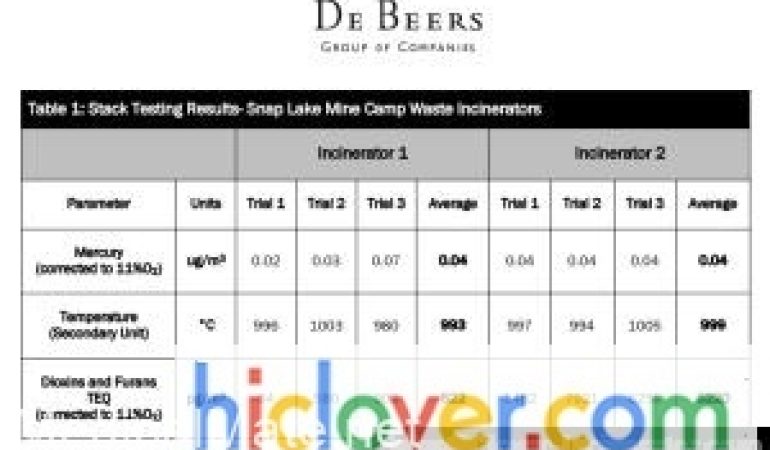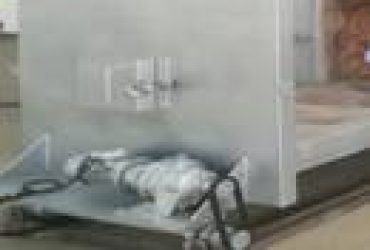Mine Spews Toxic Fumes: NWT Air Regulations Not in Position
Last July, two incinerators in De Beers’ Snap Lake Mine were belching out clouds of smoke, one sending an average of 65 times the accepted national limit of cancer-causing toxins into the atmosphere.
The elevated levels of dioxins and furans — published when plastic is burned or garbage is not fully incinerated — were recorded through a four-day”pile test” According to the World Health Organization,”dioxins are toxic and can cause developmental and reproductive difficulties, damage the immune system, interfere with hormones and also cause cancer.” The Canada-Wide Standards recommends emission levels for dioxins and furans not exceed 80 picograms per cubic metre. The business contracted to do the testing in Snap Lake discovered that among the mine incinerators was emitting 6.5 times the acceptable limit, although another incinerator was emitting a whopping 65 times the acceptable limit (5,220 picograms per cubic metre on average, as

It’s uncertain how long this was going on for, although the report noted the problem was clearly visible:”Black opaque smoke was noted for the majority of tests early in the incineration cycle”
De Beers didn’t respond to EDGE’s request for a meeting from the time of publication.
Since flunking the test, De Beers has retrained staff, rewritten operating procedures and introduced in fresh policy to close down the incinerators if they’re not meeting the right temperatures (if it is safe to do so), according to Hood’s letter. An inspection of the Snap Lake incinerators by a GNWT Lands Officer in March indicates De Beers has ameliorated the issue, at least in part:”No concerns were noted during this inspection,” it says, also”the west incinerator which was burning waste in the time of inspection was emitting apparent exhaust gas without a black smoke coming from the pile.”
whether adequate steps have been accepted, however, will not be understood for years: another stack test is not scheduled until 2019, according to a source close to the problem wishing to stay anonymous.
No GNWT law
The fact , for an undetermined time period about July 2014, the Snap Lake incinerators were pumping out unacceptable levels of toxic emissions is troublesome in itself. But it points to a far bigger problem in the land; the GNWT doesn’t regulate emissions, require organizations to meet the CWS, or mandate pile testing. (The Mackenzie Valley Land and Water Board, likewise, doesn’t regulate air pollutants.)
At several points in her letter, Hood notes the lack of law, asserting De Beers”will conform to any regulatory requirements involving incinerator stack testing once enabling legislation is approved and developed in the NWT.”
Without laws in place, there’s nothing to force De Beers or alternative groups with incinerators (i.e. every single mine in the territory), to maintain their emissions in a safe level or undertake pile testing on a regular basis. Every mine has an Air Quality and Emissions Management Plan as a part of its environmental arrangement, but these programs simply dictate coverage requirements, not actual emission targets. And while Hood claims”temptation, as measured against the Canada Wide Standards, will be managed through adaptive management and continuous improvement by De Beers,” there’s little government oversight of this”continuous improvement” and no fines or other mechanisms to force polluting businesses to cure their manners.
This difficulty has been happening for years. According to a Canadian Press report by 2011, the scientific journal Integrated Environmental Assessment and Management discovered sediments in a lake near the Ekati Mine that had levels of dioxins and furans 10 times higher than those collected in an uncontaminated lake. The same report mentioned a 2007 study commissioned by Environment Canada which indicated”extensive, uncontrolled burning of wastes could lead to substantial accumulations of dioxins and furans in the local ecosystem, some of which can persist for some 81/2 years in levels approaching those believed to be of toxicological concern”
“In most cases we’re below the level that health agencies would (watch) for…” the study continues,”but we’re getting there. And if you have more incinerators and more burning off, you may well exceed those levels.”
Why no law?
The record says:”Parties need to take measures to reduce total releases from anthropogenic sources of dioxins, furans… with the goal of their continuing minimization and where feasible (technically and socio-economically), ultimate elimination.” However, it adds,”each authority will determine the precise means of ensuring compliance” — basically defanging the record by letting states and lands renege on their commitment without any repercussions.
Other authorities have taken proactive steps, bringing in legislation to regulate emissions in keeping with the CWS. The GNWT has not. They did bring in tips for handling biomedical waste in 2005, but they’ve been reluctant to regulate incinerators at mine websites. Their reason? The”waste incinerators operating at remote industrial sites within the NWT… are situated on federal crown land and are not regulated by the Government of the Northwest Territories,” says a report by 2009.
This may have been true in 2009, however post-devolution it is no longer the case. Since April of last year, the mines are on land managed by the GNWT, yet there have been no moves from legislators to start regulating toxic emissions from mine or other industrial incinerators. The last time the issue was discussed in the legislative assembly in 2011, Weledeh MLA Bob Bromley said a”loophole in environmental rules is allowing an increasing amount of unregulated waste incinerators to discharge exceptionally toxic chemicals into the water and land.” He proposed,”when we take on new abilities, we must be ready to move with law.”
Devolution has arrived, and incinerators are still operating in an unregulated environment. With all the discussion of fracking and opening new mining jobs in the land, it is now time, even more than ever, for the GNWT to get its act together.
Other jurisdictions have taken proactive steps, bringing in legislation to regulate emissions in line with the CWS. The GNWT has not. They did bring in guidelines for managing biomedical waste in 2005, but they have been unwilling to regulate incinerators at mine sites. Their reason? The “waste incinerators operating at remote industrial sites within the NWT… are located on federal crown land and are not regulated by the Government of the Northwest Territories,” says a report from 2009.
This may have been true in 2009, but post-devolution it’s no longer the case. Since April of last year, the mines are on land managed by the GNWT, yet there have been no moves from legislators to start regulating toxic emissions from mine or other industrial incinerators. The last time the issue was discussed in the legislative assembly in 2011, Weledeh MLA Bob Bromley said a “loophole in environmental rules is allowing a growing number of unregulated waste incinerators to release extremely toxic chemicals into the land and water.” He suggested, “when we take on new powers, we must be ready to move with new law.”
Devolution has come, and incinerators are still operating in an unregulated environment. With all the talk of fracking and opening up new mining projects in the territory, it’s now time, more than ever, for the GNWT to get its act together.
from: https://edgeyk.com/article/mine-spews-toxic-fumes-nwt-air-regulations-not-in-place/




